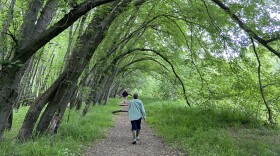For the 25th anniversary of Something Wild, we share this archive episode from 2017, featuring former Outside/In host Sam Evans-Brown.
Something Wild was in Sutton to track turkey vultures discovered living among the rocks of a cliff face near Something Wild co-host Dave Anderson’s home.
Turkey vultures are one of three vulture species living in North America. They only exist in certain environments, including cavities in a boulder field, caves in a cliff, or even big hollow logs.
Turkey vultures don’t build their own nests — they just create a depression in an existing structure — but their primary criteria is shelter from the weather. While these nests usually protect their occupants from the weather, there are other dangers. Since many nests are on the ground, they are susceptible to predation from foxes and fishers.

But they have other defenses. If a vulture feels trapped, it will give a warning hiss before vomiting on the potential threat. Imagine being covered in partially digested, putrid carrion? Any threat would beat a hasty retreat.
And that is the same method vultures use to feed their chicks. Turkey vultures are not raptors, so they don’t have powerful talons to grip or tear. Their feet can’t carry large amounts of food as they return to the nest. Instead, they bring food back for their chicks by carrying it in their crop, a little pouch in their throat. This allows them to regurgitate the crop contents to feed their chicks.

Their feeding habits are not likely to make you feel any less repelled by turkey vultures. Nor is their association with death, which makes people uncomfortable. They spend a lot of time around dead things, but correlation does not mean causation.
Vultures usually don’t turn up until after the death has occurred, and as such they play an important ecological role. In breaking down the animal protein, they aid the decomposition process, arguably preventing disease that might arise from a landscape littered with rotting meat. They could be considered the morticians of the forest.
There are so many things to admire about turkey vultures. Consider their flying prowess: They spend hours gliding for miles, flapping their wings only minimally. They rely on thermal updrafts to gain altitude and glide down to the next thermal.
However, because of their reliance on those winds, they’re not exactly early birds. They need to wait until those thermals develop each day before they can start looking for a meal; and when the morning mist is sitting heavily, those updrafts aren’t happening.
And let’s not forget that bald head of theirs. While giving them a face only a mother could love, the dearth of feathers is an important adaptation. Turkey vultures feed by diving head first into the cavities of the carcass to access the high-protein internal organs. Feathers would get in the way, and could offer a place for rotting meat and associated bacteria to cling. Since birds preen using their beak, head feathers are a liability.
It has taken thousands of generations for a bird to adapt so well to the consumption of carrion. The advent of the automobile, and the highway system developed to support it, is a surprising boon to turkey vultures — often providing an easy meal.

Something Wild is a partnership of the Forest Society, NH Audubon, and NHPR.











